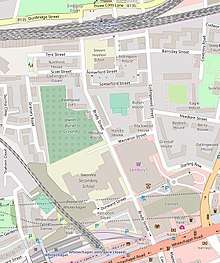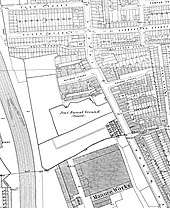Brady Street Cemetery
The Brady Street Cemetery is a disused Jewish cemetery on Brady Street in Whitechapel in the East End of London, E1. The cemetery opened in 1761 as the burial ground for the New Synagogue and was subsequently used by the Great Synagogue. It closed in 1857. Several notable people are buried there.
.jpg) The cemetery today | |
 | |
| Details | |
|---|---|
| Established | 1761 |
| Location | Brady Street, Whitechapel, (London Borough of Tower Hamlets), London E1 |
| Country | England |
| Type | Orthodox Jewish |
| Owned by | United Synagogue Burial Society |
| Size | 4 acres (1.6 ha) |
| Website | Brady Street Cemetery |
| Find a Grave | Brady Street Cemetery |

Architecture

The cemetery is 4 acres (1.6 ha) in size and is surrounded by a wall topped with broken glass.[1][2] The London: East edition of the Pevsner Architectural Guides describes the cemetery as "crowded with mainly later Victorian monuments" and highlights Miriam Levy's monument for its "considerable lavishness".[3]
History
The land the cemetery occupies was originally a brickfield on Ducking Pond Lane and was subsequently known as North Street. In 1761 it was leased to the New Synagogue for an annual rent of 12 guineas.[4] The cemetery was extended in 1795.[5]
The Brady Street Cemetery rapidly filled, and a solution was found with the addition of a four-foot layer of soil in the centre of the cemetery to allow additional burials. The raised area became known as the "Strangers Mound" as many of the new burials were not affiliated to any particular congregation.[2] The headstones of the burials in the Strangers Mound and the ones below are set back to back.[4] The Great Synagogue subsequently buried people in the New Synagogue's Jewish cemetery at West Ham after forming a Conjoint Burial Board with the New Synagogue.[6]
In the 1980s the local council intended to redevelop the cemetery with the use of a compulsory purchase order as it had not been used for many years. If a cemetery has not had any interments for 100 years it may be redeveloped, but with the burial of Victor Rothschild, 3rd Baron Rothschild in the cemetery in 1990, the future of the Brady Street Cemetery was secured from building development until at least 2090.[7][8]
The cemetery is owned by the United Synagogue and open only by appointment.[1]
Notable burials
- Financiers Benjamin (c. 1753–1808) and Abraham (c. 1756–1810) Goldsmid, both of whom committed suicide
- Rabbi of Great Britain Solomon Hirschell (1762–1842)[1]
- Hyman Hurwitz (1770–1844), the first professor of Hebrew at University College, London[1]
- Charity worker Miriam Levy (1801–1850)[1]
- Centenarian Nathan Moses who died aged 107 in 1799
- Banker Nathan Meyer Rothschild (1777–1836) and his wife Hannah Rothschild (née Barent-Cohen, 1783–1850)[1]
- Business executive and intelligence operative Victor Rothschild, 3rd Baron Rothschild (1910–1990)[7]
- Judah Cohen (1768—1838), merchant and owner of numerous slave plantations in Jamaica[9]
References
- "Brady Street Cemetery". United Synagogue. Retrieved 29 June 2017.
- Robert Bard; Adrian Miles (15 February 2017). London's Hidden Burial Grounds. Amberley Publishing. p. 109. ISBN 978-1-4456-6112-4.
- Bridget Cherry; Charles O'Brien; Nikolaus Pevsner (2005). London: East. Yale University Press. p. 559. ISBN 978-0-300-10701-2.
- Hugh Meller; Brian Parsons (1 July 2011). London Cemeteries: An Illustrated Guide & Gazetteer. History Press. ISBN 978-0-7524-9690-0.
- Christopher Hibbert; Ben Weinreb (2008). The London Encyclopaedia. Macmillan. p. 139. ISBN 978-1-4050-4924-5.
- Geoffrey Alderman (1998). Modern British Jewry. Clarendon Press. p. 86. ISBN 978-0-19-820759-7.
- Robert Bard (2014). Whitechapel & Stepney Through Time. Stroud, Gloucestershire: Amberley Publishing. ISBN 9781445642123.
- Philip Walker. "Jewish East End of London – Brady Street Cemetery". Jewish East End. Retrieved 29 June 2017.
- "COHEN Judah [Judah b Mordecai HaCohen]". Cemetery Scribes. Retrieved on 20 March 2019.
External links
| Wikimedia Commons has media related to Brady Street Cemetery. |